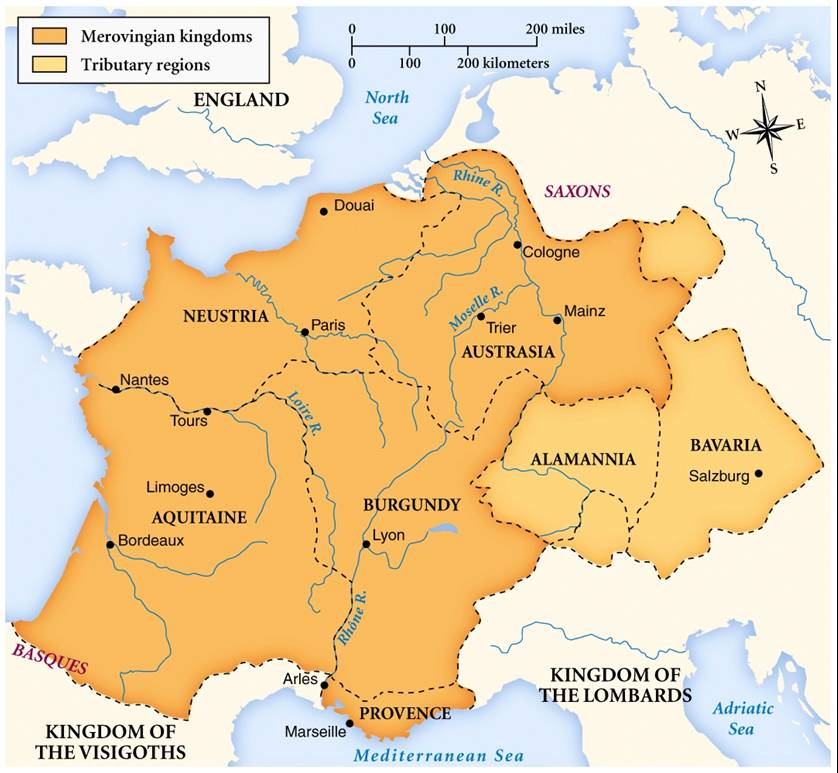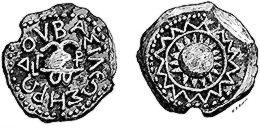|
Austregilde
Austregilde (548 580Bouyer, Christian; ''Dictionnaire des Reines de France''. Librairie Académique Perrin, 1992. p. 72. (ISBN 2-262-00789-6) (in French)), also called Austrechild, Austerchild, Austregildis, Bobilla, and Bobile, was a Frankish queen consort of the 6th century. She was not born into high social status, and was possibly a servant of Queen Marcatrude, the second wife of Guntram, King of Orléans, a servant of one of Guntram's courtiers, or even a slave in the household of Marcatrude's father. After Guntram's repudiation of his earlier queen in 565, she became his third wife. Objections to this marriage and to the legitimacy of Austregilde's children led to the deaths of Marcatrude's brothers and the banishment to a monastery of the Bishop of Gap, both on the orders of Guntram. Austregilde and Guntram had two sons, Clotaire and Clodomir, and two daughters, Clodoberge and Clotilde. Austregilde outlived her sons, who died in 576 of illness. The fates of her da ... [...More Info...] [...Related Items...] OR: [Wikipedia] [Google] [Baidu] |
Guntram
Saint Gontrand (c. 532 in Soissons – 28 March 592 in Chalon-sur-Saône), also called Gontran, Gontram, Guntram, Gunthram, Gunthchramn, and Guntramnus, was the king of the Kingdom of Orléans from AD 561 to AD 592. He was the third eldest and second eldest surviving son of Chlothar I and Ingunda. On his father's death in 561, he became king of a fourth of the Kingdom of the Franks, and made his capital at Orléans. The name "Gontrand" denotes " War Raven". Personal life King Gontrand had something of that fraternal love which his brothers lacked; the preeminent chronicler of the period, St. Gregory of Tours, often called him "good king Gontrand", as noted in the quotation below from the former's ''Decem Libri Historiarum'', in which St. Gregory discussed the fate of Gontrand's three marriages: The good king Gontrand first took a concubine Veneranda, a slave belonging to one of his people, by whom he had a son Gundobad. Later he married Marcatrude, daughter of Magnar, and ... [...More Info...] [...Related Items...] OR: [Wikipedia] [Google] [Baidu] |
Saint Aye
Aye (died c. 711) is a Belgian Catholic saint. She has been referred to also as Aia, Aya, Agia, and St. Austregildis. She is sometimes confused with another St. Agia, the mother of the French Saint Loup of Sens. Aye is revered by the Beguines of Belgium. Her Feast Day is April 18.. Little is known about Aye's early life or date of birth, but available sources state that she was the daughter of Brunulph, count d’Arennes and a relative of Saint Waldetrudis. She was married to Saint Hidulf of Hainault until both decided to enter religious life, after which point they parted ways. Aye joined the Abbey of Mons in Belgium, where she became a nun, and gave her property away to the nuns of Saint Waldetrudis. The date of her death is not concretely known as sources place her death around the year 707 as well as 714. Aye is known as the patron saint of lawsuit - A lawsuit is a proceeding by a party or parties against another in the civil court of law. The archaic term "suit in ... [...More Info...] [...Related Items...] OR: [Wikipedia] [Google] [Baidu] |
Concubine
Concubinage is an interpersonal and sexual relationship between a man and a woman in which the couple does not want, or cannot enter into a full marriage. Concubinage and marriage are often regarded as similar but mutually exclusive. Concubinage was a formal and institutionalized practice in China until the 20th century that upheld concubines' rights and obligations. A concubine could be freeborn or of slave origin, and their experience could vary tremendously according to their masters' whim. During the Mongol conquests, both foreign royals and captured women were taken as concubines. Concubinage was also common in Meiji Japan as a status symbol, and in Indian society, where the intermingling of castes and religions was frowned upon and a taboo, and concubinage could be practiced with women with whom marriage was considered undesirable, such as those from a lower caste and Muslim women who wouldn't be accepted in a Hindu household and Hindu women who wouldn't be accepted ... [...More Info...] [...Related Items...] OR: [Wikipedia] [Google] [Baidu] |
580 Deaths '', 2014
{{Numberdis ...
58 may refer to: * 58 (number) * one of the years 58 BC, AD 58, 1958, 2058 * 58 (band), an American rock band * 58 (golf), a round of 58 in golf * "Fifty Eight", a song by Karma to Burn from the album ''Arch Stanton ''Arch Stanton'' is the sixth studio album by the instrumental stoner rock band Karma to Burn. It was released on August 18, 2014 by FABA and Deepdive Records. The album will be reissued in 2023 by Heavy Psych Sounds Records. Unlike their pre ... [...More Info...] [...Related Items...] OR: [Wikipedia] [Google] [Baidu] |
548 Births
Year 548 ( DXLVIII) was a leap year starting on Wednesday (link will display the full calendar) of the Julian calendar. The denomination 548 for this year has been used since the early medieval period, when the Anno Domini calendar era became the prevalent method in Europe for naming years. Events By place Byzantine Empire * June 28 – Empress Theodora I dies at age 48, probably of breast cancer (according to Bishop Victor of Tunnuna). Her body is buried in the Church of the Holy Apostles (Constantinople). * Emperor Justinian I relieves Belisarius from military service, in favour of 70-year-old Byzantine general Narses. Europe * Theudigisel, Visigothic general, proclaims himself ruler over the Visigothic Kingdom, after King Theudis is assassinated. Persia * Lazic War: King Gubazes II revolts against the Persians, and requests aid from Justinian I. He sends a Byzantine expeditionary force (8,000 men) to Lazica (modern Georgia). * Gubazes II besieges the fortres ... [...More Info...] [...Related Items...] OR: [Wikipedia] [Google] [Baidu] |
Frankish Queens Consort
Frankish may refer to: * Franks, a Germanic tribe and their culture ** Frankish language or its modern descendants, Franconian languages * Francia, a post-Roman state in France and Germany * East Francia, the successor state to Francia in Germany * West Francia, the successor state to Francia in France * Crusaders * Levantines (Latin Christians) See also * Name of the Franks The name of the Franks (Latin ''Franci''), alongside the derived names of '' Francia'' and '' Franconia'' (and the adjectives ''Frankish'' and ''Franconian''), are derived from the name given to a Germanic tribal confederation which emerged in t ... * Franks (other) * Franconian (other) {{disambiguation Language and nationality disambiguation pages ... [...More Info...] [...Related Items...] OR: [Wikipedia] [Google] [Baidu] |
Merovingian
The Merovingian dynasty () was the ruling family of the Franks from the middle of the 5th century until 751. They first appear as "Kings of the Franks" in the Roman army of northern Gaul. By 509 they had united all the Franks and northern Gaulish Romans under their rule. They conquered most of Gaul, defeating the Visigoths (507) and the Burgundians (534), and also extended their rule into Raetia (537). In Germania, the Alemanni, Bavarii and Saxons accepted their lordship. The Merovingian realm was the largest and most powerful of the states of western Europe following the breaking up of the empire of Theodoric the Great. The dynastic name, medieval Latin or ("sons of Merovech"), derives from an unattested Frankish form, akin to the attested Old English , with the final -''ing'' being a typical Germanic patronymic suffix. The name derives from King Merovech, whom many legends surround. Unlike the Anglo-Saxon royal genealogies, the Merovingians never claimed descent fr ... [...More Info...] [...Related Items...] OR: [Wikipedia] [Google] [Baidu] |
Epitaph
An epitaph (; ) is a short text honoring a deceased person. Strictly speaking, it refers to text that is inscribed on a tombstone or plaque, but it may also be used in a figurative sense. Some epitaphs are specified by the person themselves before their death, while others are chosen by those responsible for the burial. An epitaph may be written in prose or in poem verse. Most epitaphs are brief records of the family, and perhaps the career, of the deceased, often with a common expression of love or respect—for example, "beloved father of ..."—but others are more ambitious. From the Renaissance to the 19th century in Western culture, epitaphs for notable people became increasingly lengthy and pompous descriptions of their family origins, career, virtues and immediate family, often in Latin. Notably, the Laudatio Turiae, the longest known Ancient Roman epitaph, exceeds almost all of these at 180 lines; it celebrates the virtues of an honored wife, probably of a consul. S ... [...More Info...] [...Related Items...] OR: [Wikipedia] [Google] [Baidu] |
Herod The Great
Herod I (; ; grc-gre, ; c. 72 – 4 or 1 BCE), also known as Herod the Great, was a History of the Jews in the Roman Empire, Roman Jewish client state, client king of Judea, referred to as the Herodian Kingdom of Judea, Herodian kingdom. He is known for his colossal building projects throughout Judea, including his renovation of the Second Temple#Herod's Temple, Second Temple in Jerusalem and the expansion of the Temple Mount towards its north, the enclosure around the Cave of the Patriarchs in Hebron, the construction of the port at Caesarea Maritima, the fortress at Masada, and Herodium. Vital details of his life are recorded in the works of the 1st century CE Roman–Jewish historian Josephus. Herod also appears in the Christian Gospel of Matthew as the ruler of Judea who orders the Massacre of the Innocents at the time of the Nativity of Jesus, birth of Jesus, although most Herod biographers do not believe that this event occurred. Despite his successes, including singleh ... [...More Info...] [...Related Items...] OR: [Wikipedia] [Google] [Baidu] |
Gregory Of Tours
Gregory of Tours (30 November 538 – 17 November 594 AD) was a Gallo-Roman historian and Bishop of Tours, which made him a leading prelate of the area that had been previously referred to as Gaul by the Romans. He was born Georgius Florentius and later added the name Gregorius in honour of his maternal great-grandfather. He is the primary contemporary source for Merovingian history. His most notable work was his ''Decem Libri Historiarum'' (''Ten Books of Histories''), better known as the ''Historia Francorum'' (''History of the Franks''), a title that later chroniclers gave to it. He is also known for his accounts of the miracles of saints, especially four books of the miracles of Martin of Tours. St. Martin's tomb was a major pilgrimage destination in the 6th century, and St. Gregory's writings had the practical effect of promoting highly organized devotion. Biography Gregory was born in Clermont, in the Auvergne region of central Gaul. He was born into the upper strat ... [...More Info...] [...Related Items...] OR: [Wikipedia] [Google] [Baidu] |
Bishop Of Gap
The Diocese of Gap and Embrun (Latin: ''Dioecesis Vapincensis et Ebrodunensis''; French: ''Diocèse de Gap et d'Embrun'') is a Latin Church ecclesiastical territory or diocese of the Catholic Church in Provence-Alpes-Côte d'Azur region of Southern France."Diocese of Gap" ''GCatholic.org''. Gabriel Chow. Retrieved 10 April 2017 The episcopal see is Gap Cathedral, in the city of Gap. It has a co-cathedral, the Co-cathédrale of |





